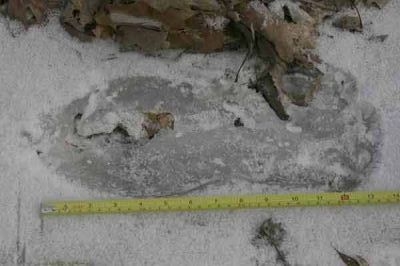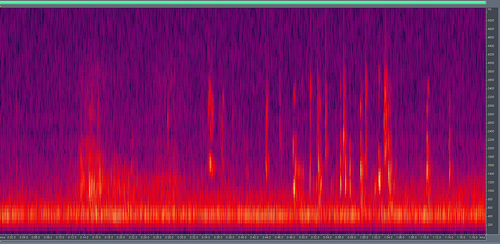The Jennifer Syndrome
I have a friend at work by the name of Jennifer. Now when the topic of bigfoot research comes up in conversation she goes into a tirade usually along the lines of – Where’s the evidence? Where’s the body? Why hasn’t one been shot?
If you mention to her that all of these questions have already been addressed on many of the websites, she laughs boldly and walks away.
This reaction to the mentioning of the word bigfoot I admit is very common in our modern American society. I am not a psychologist so I can not adequately explain or understand it other than I suspect its root causes are
1) Fear of the unknown.
2) Fear of anything associated with the dark.
3) Fear of the “boogie man” or “monsters in the closet”.
4) Concerns that we humans are not the only upright walking ape.
What about me? Am I insulted or feel put down because of the ridicule? No. Although I may disapprove of their reaction or taunts I know that it has been a common situation for a long, long time.
What about the witnesses?
I have interviewed several hundred people who have seen an animal that is not accepted to exist by the general public.
I spoke with a lady in Southern Missouri who had been traumatized by seeing an animal who came very close to her car while she was driving. She was distraught and close to tears the hour I spent with her on the phone. My role of investigating the report for the website became secondary to counseling the witness and trying to reassure her that although she had been frightened by being so close to the animal she was in no real danger.
Nighttime sighting on country dirt road in Southern Missouri.
Other encounters that can be considered somewhat harrowing are:
Couple has car shaken and sees large animal up close near Tebbetts, Missouri.
Two teenagers have sighting east of Seneca, Illinois.
Considerations for witnesses coming forward with their stories.
To even report an encounter to a family member, co-worker or a website requires that the witness admits to themselves about the incident. I have a contact who after relating the story to me about the sightings he and his wife had been having I cautioned him about telling people about it at work. It was too late, his wife had already shared her story at the office. Her co-workers laid out a trail of M & M’s down the hallway and through the office and played a game called “follow the bigfoot”.
Many witnesses that I contact express their relief that they have someone to tell their story to. Often times they are not interested in having their stores published, they are just appreciative to have had someone to listen to them. Several times I have been told “in the twenty years since my incident I have spoken to no one about this other than my spouse and you”.
Several years ago when I got involved in research my wife’s family, although not outwardly skeptical, did seem to harbor a little doubt about what I was doing. One nephew told me “I am forty years old and have hunted these woods all my life and I have never seen or heard anything out of the ordinary nor do I know anyone that has”.
On the 23rd of Jan I gave him a phone call. I said “If you are not too busy I have something I want to show you.”
As he knelt in the trail and felt the depression that each toe had made in the ice and snow I saw a different look in his eyes.
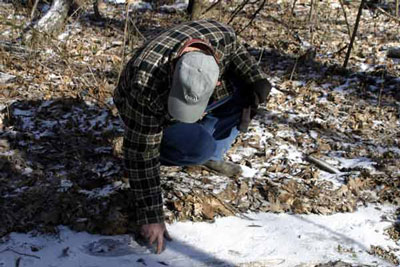
It is amazing to see someone discover for themselves what the truth is and not what they have been told by society.
The Chatterer
One of the biggest problems I faced for recording at my old place was hum from a treatment plant that was across the creek. Â Sometimes it was not heard but other times it was terrible. I recorded the following clip on the 13th of November of 2006.
Although this sound clip is not of very good quality it does show several things. This was at about 2 a.m. in a rural setting, so I know that no one was down in my woods. We also did not have any small dogs so I think the barking sounds are not of a dog. However the pattern of the barks does seem to resemble how my own dog barks, not the sounds but just the pattern.
Click here to listen to sound clip:Â Â Â Chatter 1
Waveform View
Spectral View
Peeping “Uncle Hairy”
It seems strange that an animal that supposedly is as shy and reclusive as the sasquatch would have gained the reputation for being a “peeping tom”.
The Free Dictionary defines a peeping tom as a person who stealthily peeks into windows.
There are numerous reports of sasquatches either observing people or looking in windows at people.
BFRO: Youngster frightened by “monster” peeping in window
BFRO: Daytime sighting by swimmers in Wolf Creek area
I have a contact who as a child would frequently see “red eyes” outside her bedroom window at night. This went on intermittently for seven or eight years. I spoke with her mother, now in her seventies. The mother related how her child was punished for making up stories and not wanting to sleep in that particular bedroom. It all changed one night when the mother, while checking on her daughter, also saw the “red eyes”. The family was never for sure who their peeping tom was.
An older story is found in:
Bigfoot Of the Blues by Vance Orchard copyright 1993 Walla Walla, WA p. 81
That concerned the story of Jim Ralph, retired Forest Service employee. In 1942 he was assigned to lookout duty at Hoodoo Lookout on the Walla Walla Ranger district. [This is 7 miles west of Troy, Oregon]. After spending the daylight hours in the lookout tower, Ralph would come down to spend the night in a log cabin at the base. One night after retiring he had the sensation someone was looking in his window. Checking outside he could see nobody so went back to bed.
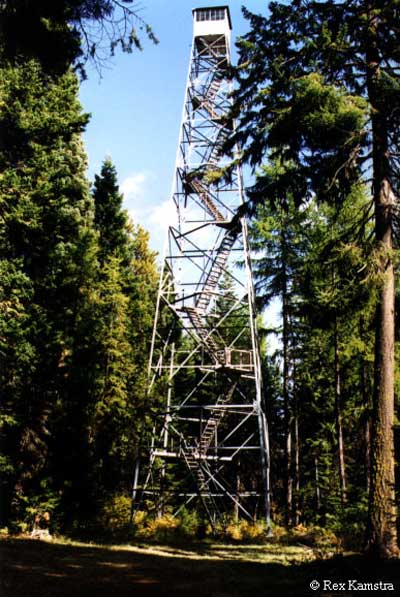
The next morning there was a set of hugh footprints, toes pointing toward his window, when he arose! Ralph recalls he followed the tracks leading away from the cabin for several miles but had to return to duty in the tower. He says he covered the two tracks at the window with a washtub until his boss came up from headquarters. “He asked me what I was going to do about them,” Ralph said. “I told him he was the boss and it was up to him. That’s the last I ever hear of it, though.”
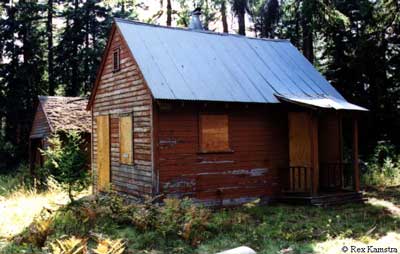
My parents and my oldest brother (who was three years old at the time) spent the summer of 1941 at this lookout tower in Wallowa County, Oregon. I wonder what my mother would have said if she had seen those giant footprints outside her window. Maybe she wouldn’t have been so skeptical.
I have often wondered if a sasquatch watched my brother (at the age of 3) playing on the steps that travel up the tower? And the next summer was that night time visitor looking for that little boy? Sadly my parents had already passed away when I became interested in this subject and subsequently found the article in the Vance Orchard books.
My only conclusion is that these animals have an extreme curiosity about us and feel secure being hidden either by the darkness or the bushes.
*photos courtesy of Rex Hamstra
Be Prepared
If there is one recommendation in research that I try to live by and encourage others to do so also is “be prepared”. The Boy Scouts of America certainly picked an appropriate motto. Although I have not necessarily recorded anything significant I have tried to learn by my mistakes, have the correct gear and hopefully keep myself alert for opportunities to record when they are presented.
In doing wildlife research I feel that the two most important pieces of equipment are some type of camera or camcorder and a audio recorder. There are many new digital camcorders on the market and prices continue to drop. For doing a remote video setup I happen to like the Sony analog because it has 4 hours on long play and the aperture can be opened up to allow in more light. For audio recorder recommendations please see my soundrecording page.
I have had some successes and many failures in my quest to be ready. In March of 2005 I happened to be fortunate enough to get a digital still picture of a bobcat.

I was walking along a pond when Belle, my Karelian Bear Dog, assumed a point position. I saw some motion in the grass at about 300 yards distance. I immediately started clicking pictures. I did not know at the time what it was, I thought perhaps coyote until I downloaded the pictures on my computer. Even in the corn stubble the bobcat was still very well camouflaged.
On the 29th of August 2006 I had a cougar cross the road in front of my pickup at 7 a.m. in broad daylight. Was I prepared, no. If I had my camcorder running, sitting on the dash I would have perhaps recorded an excellent sequence. I had stopped the vehicle to allow my dog to greet the farmers dog that always comes out to say hello. When I looked back up the road the big cat was crossing the road only 50 feet in front of me. Since then I keep my camcorder running on the dash when I get within a mile of my research area.
I try to do 10 hr remote audio recording every night. My audio recordings can be found at:
my unknown sounds and bird and animal sounds.
Doing remote video setup I have taken video’s of deer, possum, coyote, bobcat, fox, squirrel, rabbit. Of course using night vision the pictures are never as good as daytime. Some of these can be found at:
I think the future is bright for researchers getting new recordings. Prices have plummeted for both audio and video equipment. Almost everyone can now afford to have at least some type of recording gear. And whatever you do, always keep your recorders running while in the field.
Habituation
Habituation is an interesting controversial subject in Sasquatch research. Over the years there have been several cases of people making claims of long term interactions with families of bigfoot. I have been fortunate enough to personally investigate two of these situations.
I have a Native American friend, John, who lives along the Illinois River in North-Central Illinois. For the last twenty years he has routinely spent time in the woods near his home. I can not prove his claims nor do I have any evidence as to what I have witnessed while I was with him. My friend is a soft spoken man, suspicious of outsiders and what their intentions are when it comes to the large animals that live in his woods. He was concerned about both the welfare of the animals plus how I would handle myself if the animals came in real close. After several meetings with John he eventually agreed to allow me to tag-along with him on one of his outings.
We arrived on location about forty-five minutes before sundown to take up our positions. As we stepped into the woods I heard a howl coming from around the hill, and then it was repeated again. I was amazed. John said “They know me”. Slowly we worked our way through the brush and upwards the base of a low lying hill. As the sun was going down we sat on the ground and awaited our “guests” or should I say that perhaps we were the “guests”. John explained that he had this “special technique” to draw the animals in. He would bang together two wooden sticks and set up a rhythm while singing a traditional chant. Many times the animals would come in very close to investigate, sometimes within ten feet. John said to keep our heads down and not to make eye contact. As with the great apes, eye contact would be considered a threat and the animals would leave.
During the twilight John sang his chant and we anxiously waited to see if we would be visited. On top of the hill 125 yards away I heard a wood knock. John said “they are coming”. I could hear movement behind me and to my left. For the next fifteen minutes we could detect brush being moved out of the way as something was approaching. I expectantly waited for whatever was hidden to show itself. The movement stopped about fifteen feet away in the nearest brush. We sat there for thirty minutes listening to the night sounds. Our “friends” did not come out in the open that night. Perhaps they were just being cautious about this stranger carrying a camcorder and recorder. We slowly made our way back to the van in the dark. Although somewhat disappointed I was still excited to have been let in to one man’s world, a world that the general public does not acknowledge or understand.
A Quiz and a Challenge – What are These Sounds in the Night?
One of the most interesting areas of research in wildlife is sounds. Whether it is different frogs croaking, bird singing or coyotes howling we can make recordings and do computer analysis of these sounds.
In the area of bird identification when so many times the birder is not able to see the vocalist because of heavy brush, bird songs and calls have become a major resource. CD collections of American birds are inexpensive. Examples are:
Stokes Field Guide to Bird Songs
A Field Guide to Bird Songs: Eastern and Central North America (Peterson Field Guides)
The major institution that is deeply involved with bird sounds is:
When it comes to mammal sounds it is more difficult. Darkness does not lend itself to easy identification of sounds. Most birds are active in the daytime (owls and nighthawks and a few others being the exception). The mammals are a different story. Although all mammals are seen at different times of the day, other than the squirrel family, most are chiefly active in the night.
Numerous websites have collections of mammal sounds:
Guide to Animal Sounds on the Net
Hunting websites often carry large collections of the more common mammals:
Varmint Al’s Coyote Hunting Page
Bioacoustics
According to Wikipedia:
Bioacoustics is the study of how animals use sound for communication and echolocation.
Major institutions that are involved in bioacoustics include:
Texas A & M University-Corpus Christ
Cornell Lab of Ornithology
Bioacoustics Research Program (note: also includes mammals)
Sound Analysis
The advent of computers has allowed scientists and amateur alike to study sounds in an objective manner. It is not enough to say “oh that sounds like a coyote or that is just a mountain lion screamingâ€. It needs to be recorded with high quality field recorders and microphones. It then needs to be analyzed by computer software.
There are many different programs for evaluating sounds:
For a longer list of programs check out:
Sound Analysis Software for bioacoustics
A Quiz and a Challenge:
What is this animal? I recorded this sound during April and May in Central Illinois along a creek in a mixed oak-hickory forest.
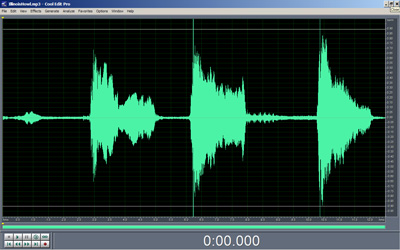
To answer the challenge one must be able to have a recording that is good enough quality to be analyzed. A poorly recorded and distorted recording has no value. To be considered the same animal the recording must:
1. Display the same pattern.
2. Display the same resonant frequency and overtones.
If you think you know what this animal is please send me a recording for analysis. My email address is: stancourtney@hotmail.com
For a further discussion on this howl please see:
and for all the recordings of this howl see:
